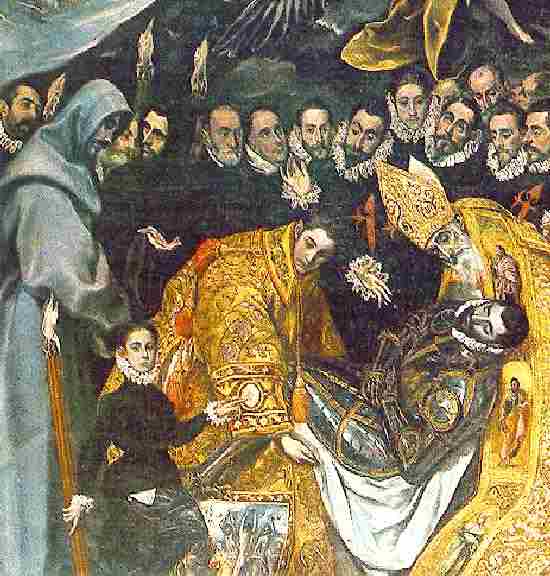
Figure 1.-This detail from El Greco's masterpiece "The Burial of Count Orgaz" shows his son, Jorge Manuel, is depicted as a page. Note the heavily ruffled collar.


Figure 1.-This detail from El Greco's masterpiece "The Burial of Count Orgaz" shows his son, Jorge Manuel, is depicted as a page. Note the heavily ruffled collar. |
El Greco (the Greek) was born on Crete. He is best known for his painting, but he was a sculptor and architect as well. Crete at the time was under Venetian control. While born on Crete, he is more associated with Spain where he settled. He is the first great Spanish artist. His actual name was Domenikos Theotocopoulos. Despite working in Spain, he always in Greek characters, sometimes followed by Kres (Cretan). Other than portraits, most of his paintings has religious themes. We know only a few works in which boys were depicted showing the fashions of the day in Spain. El Greco's style is noted for elogated almost mystical figures, leading some to call him the greatest mannerist in the history of art.
We know little about his childhood. We know that he was born and raised on Crete, a large island south of Grece. His actual name was Domenikos Theotocopoulos.
Only a few works survive by him in the Byzantine tradition of icon painting. We know he was active in the 1560s on Cretae and was referred to as a master painter. Around 1566 he went to Venice. Venice was an important naval power in the 16th century and controlled Crete. He then moved on to Rome. A document at the time refered to him as a pupil of Titian. Many believe that Tintoretto influenced him more. Michelangelo also had an important influence.
El Greco had reached Toledo by 1577. There he remained until his death and painted his great masterpieces. It was in Toledo that El Greco perfected his characteristic, instantly recognizable style . Spain at the time was at the apogee of its military power. Wealth was flowing in from the Americas to finace a powerful military machine. Domestically Spain was being purified by the inquisition. Jews were being expelled and the Hapsburg monarchs were waging war in the Counter-Recormation against Protestants, especially in the Netherlands and Germany. The armadas were dispatched to England. Diego de Castilla, Dean of Canons at Toledo Cathedral, whom El Greco had met in Rome, had arranged a commision for him. The commissopn was an altarpieve and many additional, altarpieces followed. Perhaps his graetest work is "The Burial of Count Orgaz". It was painted as the alatarpiece at S. Tomé in Toledo (1586-88). This powerful work vividly expresses an awesomeness spiritual event.
El Greco's style is noted for elogated figures, seemingly straining upward. They give his work a mystical quality, leading some to call him the greatest mannerist in the history of art. His figures are unaturally elongated into sometimes flame-like forms. They are usually painted in cold, almost eerie, bluish colors. This apparently was done express intense religious feeling. The destinctivness of his work has spawned various theories, for example that he was mad or suffered from astigmatism. Others maiantain that his paintings express the intense religious fervour of late 16th century Spain.
El Greco also painted many great portraits, although we do not know any of children. "The Burial of Count Orgaz" is in fact a tour de force in portrait painting.
Many consider "The Burial of Count Orgaz" as El Greco's masterpiece. The painting depicts a local legend. Don Gonzalo Ruíz, native of Toledo, and Señor of the town of Orgaz, died in 1352. (The family only received the title of Count described in the title later.) The Count was apparently a pious man who left moneys for the church of Santo Tomé (El Greco's parish church). El Greco pictures no less than Saint Stephen and Saint Augustine assisting in the burial. The portrait was acclaimed at the time, because the men depicted were the most important men of Toledo wjen the piece was painted and this all portraits. Many of the men are unknown. The artist himself is the third from the left. El Grco's young son Jorge Manuel acts as young page in the lower left corner.
The page wears a black outfit and few details can be made out except for the heavily ruffled collar.
El Greco was aproud man. He thought of himself as an artist-philosopher rather that a mere painter. He maintained a lavish life-style. While he received many church comissions, he did notvasucced in obtaining royal patronage that he desired for both the commissions and prestige. He apparently had financial difficulties at the end of his life becase of the lavish spending. He maintained a workshop that produced replicas of his paintings.
Two sons also followed their father as artists, Jorge Manuel Theotocopouli and Luis Tristán. Jorge Manuel is the boy depicted as a page in "The Burial of Count Orgaz". Note how similarly the boy is dressed like the men.
Navigate the Boys' Historical Clothing Artist pages:
[Return to the Main Greek page]
[Return to the Main indvidual A-L artist page]
[Chronology]
[Countries]
[Individuals]
[Styles]
Navigate the Boys' Historical Clothing Web Site:
[Introduction]
[Activities]
[Bibliographies]
[Biographies]
[Chronology]
[Clothing styles]
[Countries]
[Contributions]
[FAQs]
[French glossary]
[Satellite sites]
[Tools]
[Boys' Clothing Home]
